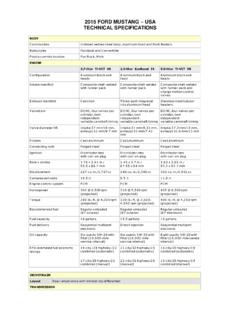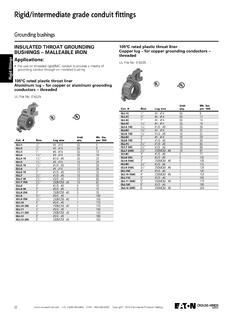Transcription of Aluminum and Aluminum Alloys - NIST
1 Aluminum andAluminum AlloysIntroduction and OverviewGeneral unique combinations of properties provided by Aluminum and its Alloys make Aluminum one of the most ver-satile, economical, and attractive metallic materials for a broad range ofuses from soft, highly ductile wrapping foil to the most demanding engi-neering applications. Aluminum Alloys are second only to steels in use asstructural has a density of only g/cm3, approximately one-third asmuch as steel ( g/cm3). One cubic foot of steel weighs about 490 lb;a cubic foot of Aluminum , only about 170 lb. Such light weight, coupledwith the high strength of some Aluminum Alloys (exceeding that of struc-tural steel), permits design and construction of strong, lightweight structuresthat are particularly advantageous for anything that moves space vehi-cles and aircraft as well as all types of land- and water-borne resists the kind of progressive oxidization that causes steel torust away.
2 The exposed surface of Aluminum combines with oxygen to forman inert Aluminum oxide film only a few ten-millionths of an inch thick,which blocks further oxidation. And, unlike iron rust, the Aluminum oxidefilm does not flake off to expose a fresh surface to further oxidation. If theprotective layer of Aluminum is scratched, it will instantly reseal thin oxide layer itself clings tightly to the metal and is colorless andtransparent invisible to the naked eye. The discoloration and flaking ofiron and steel rust do not occur on alloyed and treated, Aluminum can resist corrosion bywater, salt, and other environmental factors, and by a wide range of otherchemical and physical agents. The corrosion characteristics of aluminumalloys are examined in the section Effects of Alloying on CorrosionBehavior in this : Understanding the Davis, p351-416 2001 ASM International All rights reserved.
3 / Light Metals and AlloysAluminum surfaces can be highly reflective. Radiant energy, visiblelight, radiant heat, and electromagnetic waves are efficiently reflected,while anodized and dark anodized surfaces can be reflective or reflectance of polished Aluminum , over a broad range of wavelengths, leads to its selection for a variety of decorative and typically displays excellent electrical and thermal conduc-tivity, but specific Alloys have been developed with high degrees of elec-trical resistivity. These Alloys are useful, for example, in high-torqueelectric motors. Aluminum is often selected for its electrical conductivity,which is nearly twice that of copper on an equivalent weight basis. Therequirements of high conductivity and mechanical strength can be met byuse of long-line, high-voltage, Aluminum steel-cored reinforced transmis-sion cable. The thermal conductivity of Aluminum Alloys , about 50 to 60%that of copper, is advantageous in heat exchangers, evaporators, electri-cally heated appliances and utensils, and automotive cylinder heads is nonferromagnetic, a property of importance in the electri-cal and electronics industries.
4 It is nonpyrophoric, which is important inapplications involving inflammable or explosive-materials handling orexposure. Aluminum is also non-toxic and is routinely used in containersfor food and beverages. It has an attractive appearance in its natural finish,which can be soft and lustrous or bright and shiny. It can be virtually anycolor or ease with which Aluminum may be fabricated into any form is oneof its most important assets. Often it can compete successfully withcheaper materials having a lower degree of workability. The metal can becast by any method known to foundrymen. It can be rolled to any desiredthickness down to foil thinner than paper. Aluminum sheet can bestamped, drawn, spun, or roll formed. The metal also may be hammeredor forged. Aluminum wire, drawn from rolled rod, may be stranded intocable of any desired size and type. There is almost no limit to the differ-ent profiles (shapes) in which the metal can be Categories.
5 It is convenient to divide Aluminum Alloys into twomajor categories: wrought compositions and cast compositions. A furtherdifferentiation for each category is based on the primary mechanism ofproperty development. Many Alloys respond to thermal treatment based onphase solubilities. These treatments include solution heat treatment,quenching, and precipitation, or age, hardening. For either casting orwrought Alloys , such Alloys are described as heat treatable. A large numberof other wrought compositions rely instead on work hardening throughmechanical reduction, usually in combination with various annealing pro-cedures for property development. These Alloys are referred to as workhardening. Some casting Alloys are essentially not heat treatable and areused only in as- cast or in thermally modified conditions unrelated to solu-tion or precipitation and wrought alloy nomenclatures have been developed.
6 TheAluminum Association system is most widely recognized in the UnitedStates. Their alloy identification system employs different nomenclaturesfor wrought and cast Alloys , but divides Alloys into families for simplifi-cation. For wrought Alloys a four-digit system is used to produce a list ofwrought composition families as follows: 1xxx:Controlled unalloyed (pure) composition, used primarily in theelectrical and chemical industries 2xxx: Alloys in which copper is the principal alloying element,although other elements, notably magnesium, may be specified. 2xxx-series Alloys are widely used in aircraft where their high strength(yield strengths as high as 455 MPa, or 66 ksi) is valued. 3xxx: Alloys in which manganese is the principal alloying element,used as general-purpose Alloys for architectural applications and vari-ous products 4xxx: Alloys in which silicon is the principal alloying element, used inwelding rods and brazing sheet 5xxx: Alloys in which magnesium is the principal alloying element,used in boat hulls, gangplanks, and other products exposed to marineenvironments 6xxx: Alloys in which magnesium and silicon are the principal alloy-ing elements, commonly used for architectural extrusions and auto-motive components 7xxx: Alloys in which zinc is the principal alloying element (althoughother elements, such as copper, magnesium, chromium, and zirconium,may be specified), used in aircraft structural components and otherhigh-strength applications.
7 The 7xxxseries are the strongest aluminumalloys, with yield strengths 500 MPa ( 73 ksi) possible. 8xxx: Alloys characterizing miscellaneous compositions. The 8xxxseriesalloys may contain appreciable amounts of tin, lithium, and/or iron. 9xxx:Reserved for future useWrought Alloys that constitute heat-treatable (precipitation-hardenable) Aluminum Alloys include the 2xxx,6xxx,7xxx,and some of the 8xxxalloys. The various combinations of alloying additions and strengtheningmechanisms used for wrought Aluminum Alloys are shown in Table 1. Thestrength ranges achievable with various classes of wrought and cast alloysare given in Tables 2 and compositions are described by a three-digit system followed by adecimal value. The decimal .0 in all cases pertains to casting alloy .1, and .2 concern ingot compositions, which after melting and pro-cessing should result in chemistries conforming to casting specificationrequirements. Alloy families for casting compositions include the following: Aluminum and Aluminum Alloys / 353 :Controlled unalloyed (pure) compositions, especially for rotormanufacture : Alloys in which copper is the principal alloying element.
8 Otheralloying elements may be specified. : Alloys in which silicon is the principal alloying element. Theother alloying elements such as copper and magnesium are comprises nearly 90% of all shaped castings pro-duced. : Alloys in which silicon is the principal alloying element. : Alloys in which magnesium is the principal alloying element. :Unused : Alloys in which zinc is the principal alloying element. Otheralloying elements such as copper and magnesium may be specified. : Alloys in which tin is the principal alloying element. :UnusedHeat-treatable casting Alloys include the 2xx,3xx,and 4 and 5 list nominal compositions for representative wrought andcast Aluminum Alloys . It should be noted that the alloy compositions list-ed in these tables make up a rather small percentage of the total amountof compositions developed. More than 500 alloy designations/composi-tions have been registered by the Aluminum Association Inc.
9 For alu-minum Alloys . Composition limits for these Alloys can be found in theMetals Handbook Desk Edition,2nd ed., (see the article ChemicalCompositions and International Designations on pages 426 436) and inRegistration Records on wrought Alloys , castings, and ingots published bythe Aluminum / Light Metals and AlloysTable 1 Classification of wrought Aluminum alloysaccording to their strengthening mechanismAlloy system Aluminum seriesWork-hardenable alloysPure Al 1xxxAl-Mn 3xxxAl-Si 4xxxAl-Mg 5xxxAl-Fe 8xxxAl-Fe-Ni 8xxxPrecipitation-hardenable alloysAl-Cu 2xxxAl-Cu-Mg 2xxxAl-Cu-Li 2xxxAl-Mg-Si 6xxxAl-Zn
10 7xxxAl-Zn-Mg 7xxxAl-Zn-Mg-Cu 7xxxAl-Li-Cu-Mg 8xxxAluminum and Aluminum Alloys / 355 Table 2 Strength ranges of various wrought Aluminum alloysAluminumType ofTensileAssociationalloyStrengtheningst rength rangeseriescompositionmethodMPa ksi1xxxAl Cold work 70 175 10 252xxxAl-Cu-MgHeat treat170 31025 45(1 Cu)2xxxAl-Cu-Mg-SiHeat treat380 52055 75(3 6% Cu)3xxxAl-Mn-Mg Cold work 140 280 20 404xxxAl-Si Cold work105 35015 50(some heat treat)5xxxAl-MgCold work140 28020 40(1 Mg)5xxxAl-Mg-MnCold work280 38040 55(3 6% Mg) 6xxxAl-Mg-Si Heat treat 150 380 22 557xxxAl-Zn-Mg Heat treat 380 520 55 757xxxAl-Zn-Mg-Cu Heat treat 520 620 75 908xxxAl-Li-Cu-Mg Heat treat 280 560 40 80 Table 3 Strength ranges of various cast Aluminum alloysTensile strength rangeAlloy system (AA designation) MPa ksiHeat treatable sand cast Alloys (various tempers) Al-Cu (201 206) 353 467 51 68Al-Cu-Ni-Mg (242) 186 221 27 32Al-Cu-Si (295) 110 221 16 32Al-Si-Cu (319) 186 248 27 36Al-Si-Cu-Mg (355, 5% Si, Cu, Mg) 159 269 23 39Al-Si-Mg (356, 357) 159 345 23 50Al-Si-Cu-Mg (390, 17% Si, Cu, Mg)




